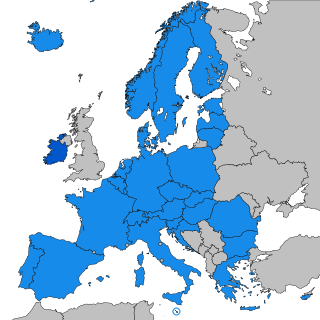
Privacy is the ability of an individual or group to seclude themselves or information about themselves, and thereby express themselves selectively.

The Schengen Information System (SIS) is a governmental database maintained by the European Commission. The SIS is used by 31 European countries to find information about individuals and entities for the purposes of national security, border control and law enforcement since 2001. A second technical version of this system, SIS II, went live on 9 April 2013. An upgraded Schengen Information System entered into operation on 7 March 2023.
Personal data, also known as personal information or personally identifiable information (PII), is any information related to an identifiable person.
Data retention defines the policies of persistent data and records management for meeting legal and business data archival requirements. Although sometimes interchangeable, it is not to be confused with the Data Protection Act 1998.
A cybersecurity regulation comprises directives that safeguard information technology and computer systems with the purpose of forcing companies and organizations to protect their systems and information from cyberattacks like viruses, worms, Trojan horses, phishing, denial of service (DOS) attacks, unauthorized access and control system attacks. While cybersecurity regulations aim to minimize cyber risks and enhance protection, the uncertainty arising from frequent changes or new regulations can significantly impact organizational response strategies.
Privacy law is the body of law that deals with the regulating, storing, and using of personally identifiable information, personal healthcare information, and financial information of individuals, which can be collected by governments, public or private organisations, or other individuals. It also applies in the commercial sector to things like trade secrets and the liability that directors, officers, and employees have when handling sensitive information.
The Internet of things (IoT) describes devices with sensors, processing ability, software and other technologies that connect and exchange data with other devices and systems over the Internet or other communications networks. The Internet of things encompasses electronics, communication, and computer science engineering. "Internet of things" has been considered a misnomer because devices do not need to be connected to the public internet; they only need to be connected to a network and be individually addressable.

Cloud computing is the on-demand availability of computer system resources, especially data storage and computing power, without direct active management by the user. Large clouds often have functions distributed over multiple locations, each of which is a data center. Cloud computing relies on sharing of resources to achieve coherence and typically uses a pay-as-you-go model, which can help in reducing capital expenses but may also lead to unexpected operating expenses for users.
Cloud computing security or, more simply, cloud security, refers to a broad set of policies, technologies, applications, and controls utilized to protect virtualized IP, data, applications, services, and the associated infrastructure of cloud computing. It is a sub-domain of computer security, network security, and, more broadly, information security.

Electronic evidence consists of these two sub-forms:

The General Data Protection Regulation is a European Union regulation on information privacy in the European Union (EU) and the European Economic Area (EEA). The GDPR is an important component of EU privacy law and human rights law, in particular Article 8(1) of the Charter of Fundamental Rights of the European Union. It also governs the transfer of personal data outside the EU and EEA. The GDPR's goals are to enhance individuals' control and rights over their personal information and to simplify the regulations for international business. It supersedes the Data Protection Directive 95/46/EC and, among other things, simplifies the terminology.

In internet governance, network sovereignty, also called digital sovereignty or cyber sovereignty, is the effort of a governing entity, such as a state, to create boundaries on a network and then exert a form of control, often in the form of law enforcement over such boundaries.
The right to be forgotten (RTBF) is the right to have private information about a person be removed from Internet searches and other directories under some circumstances. The issue has arisen from desires of individuals to "determine the development of their life in an autonomous way, without being perpetually or periodically stigmatized as a consequence of a specific action performed in the past". The right entitles a person to have data about them deleted so that it can no longer be discovered by third parties, particularly through search engines.
Cloud computing is used by most people every day but there are issues that limit its widespread adoption. It is one of the fast developing area that can instantly supply extensible services by using internet with the help of hardware and software virtualization. Cloud computing biggest advantage is flexible lease and release of resources as per the requirement of the user. Its other advantages include efficiency, compensating the costs in operations and management. It curtails down the high prices of hardware and software
The main idea of Schengen Routing is to apply a European internet routing policy such that when sender and recipient are inside the Schengen Area, data between the two endpoints is also routed entirely within the Schengen area.
The EU–US Privacy Shield was a legal framework for regulating transatlantic exchanges of personal data for commercial purposes between the European Union and the United States. One of its purposes was to enable US companies to more easily receive personal data from EU entities under EU privacy laws meant to protect European Union citizens. The EU–US Privacy Shield went into effect on 12 July 2016 following its approval by the European Commission. It was put in place to replace the International Safe Harbor Privacy Principles, which were declared invalid by the European Court of Justice in October 2015. The ECJ declared the EU–US Privacy Shield invalid on 16 July 2020, in the case known as Schrems II. In 2022, leaders of the US and EU announced that a new data transfer framework called the Trans-Atlantic Data Privacy Framework had been agreed to in principle, replacing Privacy Shield. However, it is uncertain what changes will be necessary or adequate for this to succeed without facing additional legal challenges.
Data sovereignty is the idea that data are subject to the laws and governance structures of the nation where they are collected. The concept of data sovereignty is closely linked with data security, cloud computing, network sovereignty, and technological sovereignty. Unlike technological sovereignty, which is vaguely defined and can be used as an umbrella term in policymaking, data sovereignty is specifically concerned with questions surrounding the data itself. Data sovereignty as the idea that data is subject to the laws and governance structures within one nation is usually discussed in one of two ways: in relation to Indigenous groups and Indigenous autonomy from post-colonial states, or in relation to transnational data flow. The latter case is dealt with extensively in a new anthology. With the rise of cloud computing, many countries have passed various laws around the control and storage of data, which all reflect measures of data sovereignty. More than 100 countries have some sort of data sovereignty laws in place. With self-sovereign identity (SSI), the individual identity holders can fully create and control their credentials, although a nation can still issue a digital identity in that paradigm.
A data economy is a global digital ecosystem in which data is gathered, organized, and exchanged by a network of companies, individuals, and institutions to create economic value. The raw data is collected by a variety of actors, including search engines, social media websites, online vendors, brick and mortar vendors, payment gateways, software as a service (SaaS) purveyors, and an increasing number of firms deploying connected devices on the Internet of Things (IoT). Once collected, this data is typically passed on to individuals or firms, often for a fee. In the United States, the Consumer Financial Protection Bureau and other agencies have developed early models to regulate the data economy.
The regulation of artificial intelligence is the development of public sector policies and laws for promoting and regulating artificial intelligence (AI); it is therefore related to the broader regulation of algorithms. The regulatory and policy landscape for AI is an emerging issue in jurisdictions globally, including in the European Union and in supra-national bodies like the IEEE, OECD and others. Since 2016, a wave of AI ethics guidelines have been published in order to maintain social control over the technology. Regulation is considered necessary to both encourage AI and manage associated risks. In addition to regulation, AI-deploying organizations need to play a central role in creating and deploying trustworthy AI in line with the principles of trustworthy AI, and take accountability to mitigate the risks. Regulation of AI through mechanisms such as review boards can also be seen as social means to approach the AI control problem.

Microsoft 365 is a product family of productivity software, collaboration and cloud-based services owned by Microsoft. It encompasses online services such as Outlook.com, OneDrive, Microsoft Teams, programs formerly marketed under the name Microsoft Office, enterprise products and services associated with these products such as Exchange Server, SharePoint, and Viva Engage. It also covers subscription plans encompassing these products, including those that include subscription-based licenses to desktop and mobile software, and hosted email and intranet services.






